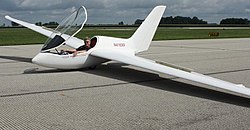Design and development
The first Pioneer began as an aircraft construction project of Walt MacFarlane in 1965, but he did not complete the aircraft. The partially completed project was purchased by Bill Daniels and Jim Marske in 1967, who completed it and first flew the aircraft in 1968. That prototype, serial number 1, registered N7910 was still registered to Daniels in 2011. [2] [3] [5]
In its original configuration the Pioneer had a 40 ft (12.2 m) wingspan. The aircraft was constructed with a wood and doped fabric wing, with the fuselage made from steel tube and fiberglass. The design features a fixed monowheel landing gear, flaps for glide-path control and spoilers for roll control instead of the more usual ailerons. [3] [4]
The original Pioneer was modified with wing extensions, bringing the span to 46 ft (14.0 m) and it was re-designated the Pioneer IA. In this configuration the aircraft can fly as slowly as 28 kn (52 km/h) or as fast as 140 kn (259 km/h). [2] [3]
The original design was simplified for homebuilt construction, retaining the wood and fabric wing construction, but the fuselage was changed to a fiberglass structure. The wingspan was shortened to 42.64 ft (13.0 m) to allow the wings to be built in a standard 20 ft (6.1 m) deep garage. Unlike on the original design, roll control was changed to ailerons, with upper surface spoilers paired with lower surface dive brakes for glidepath control. Because the aircraft is tailless the centre of gravity range is very narrow. To simplify weight and balance considerations the monowheel landing gear is located on the desired C of G and the pilot's seat is adjustable fore-and-aft. The pilot simply moves the seat until the aircraft balances on the wheel to ensure that the balance is within the center-of-gravity range. The empty weight is 390 lb (177 kg) with a gross weight of 630 lb (286 kg). The aircraft manages a 35:1 glide ratio and a minimum sink of 2.26 ft/s (0.69 m/s). [2] [3]
Starting in 1972 the Pioneer II was made available as plans or as a kit. The kit included a pre-made fiberglass fuselage shell. Reported building times range from 600 to 2000 hours. At least one Pioneer II was modified with a 45.93 ft (14.0 m) wingspan. [2] [3]
Marske has built a prototype Pioneer III, an all-composite variant of the basic design. The Pioneer III is intended to be 100 lb (45 kg) lighter than the Pioneer II, produce a 20% drag reduction and be optimized for flight in weak lift conditions. [6]
This page is based on this
Wikipedia article Text is available under the
CC BY-SA 4.0 license; additional terms may apply.
Images, videos and audio are available under their respective licenses.

